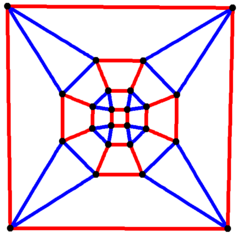Small rhombicuboctahedron
| Rhombicuboctahedral graph | |
|---|---|

4-fold symmetry
|
|
| Vertices | 24 |
| Edges | 48 |
| Automorphisms | 48 |
| Properties | Quartic graph, Hamiltonian, regular |
In geometry, the rhombicuboctahedron, or small rhombicuboctahedron, is an Archimedean solid with eight triangular and eighteen square faces. There are 24 identical vertices, with one triangle and three squares meeting at each. (Note that six of the squares only share vertices with the triangles while the other twelve share an edge.) The polyhedron has octahedral symmetry, like the cube and octahedron. Its dual is called the deltoidal icositetrahedron or trapezoidal icositetrahedron, although its faces are not really true trapezoids.
Johannes Kepler in Harmonices Mundi (1618) named this polyhedron a rhombicuboctahedron, being short for truncated cuboctahedral rhombus, with cuboctahedral rhombus being his name for a rhombic dodecahedron. This truncation creates new vertices mid-edge to the rhombic dodecahedron, creating rectangular faces inside the original rhombic faces, and new square and triangle faces at the original vertices. The semiregular form here requires the geometry be adjusted so the rectangles become squares.
It can also be called an expanded cube or cantellated cube or a cantellated octahedron from truncation operations of the uniform polyhedron.
There are distortions of the rhombicuboctahedron that, while some of the faces are not regular polygons, are still vertex-uniform. Some of these can be made by taking a cube or octahedron and cutting off the edges, then trimming the corners, so the resulting polyhedron has six square and twelve rectangular faces. These have octahedral symmetry and form a continuous series between the cube and the octahedron, analogous to the distortions of the rhombicosidodecahedron or the tetrahedral distortions of the cuboctahedron. However, the rhombicuboctahedron also has a second set of distortions with six rectangular and sixteen trapezoidal faces, which do not have octahedral symmetry but rather Th symmetry, so they are invariant under the same rotations as the tetrahedron but different reflections.
...
Wikipedia
